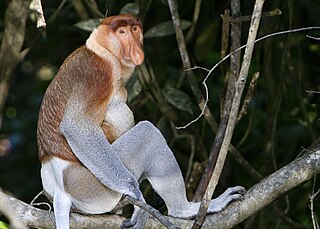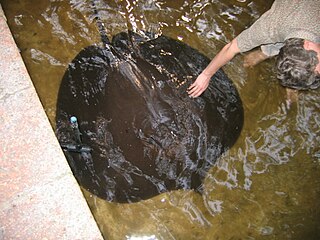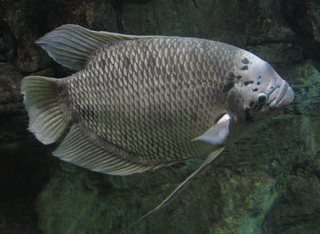
The Asian arowana comprises several phenotypic varieties of freshwater fish distributed geographically across Southeast Asia. While most consider the different varieties to belong to a single species, work by Pouyaud et al. (2003) differentiates these varieties into multiple species. They have several other common names, including Asian bonytongue, dragonfish, and a number of names specific to the different color varieties.

Gouramis, or gouramies, are a group of freshwater anabantiform fish that comprise the family Osphronemidae. The fish are native to Asia—from the Indian Subcontinent to Southeast Asia and northeasterly towards Korea. The name "gourami", of Indonesian origin, is also used for fish of the families Helostomatidae and Anabantidae.

The proboscis monkey or long-nosed monkey is an arboreal Old World monkey with an unusually large nose, a reddish-brown skin color and a long tail. It is endemic to the southeast Asian island of Borneo and is found mostly in mangrove forests and on the coastal areas of the island.

The stream catfishes comprise the family Akysidae of catfishes.

The Borneo shark is a species of requiem shark, and part of the family Carcharhinidae. Extremely rare, it is known only from inshore waters around Mukah in northwestern Borneo, though it may once have been more widely distributed. A small, gray shark reaching 65 cm (26 in) in length, this species is the only member of its genus with a row of enlarged pores above the corners of its mouth. It has a slender body with a long, pointed snout and a low second dorsal fin placed posterior to the anal fin origin.

The giant freshwater stingray is a species of stingray in the family Dasyatidae. It is found in large rivers and estuaries in Southeast Asia and Borneo, though historically it may have been more widely distributed in South and Southeast Asia. The largest freshwater fish and the largest stingray in the world, this species grows up to 2.2 m (7.2 ft) across and can reach up to 300 kg (660 lb) in weight. It has a relatively thin, oval pectoral fin disc that is widest anteriorly, and a sharply pointed snout with a protruding tip. Its tail is thin and whip-like, and lacks fin folds. This species is uniformly grayish brown above and white below; the underside of the pectoral and pelvic fins bear distinctive wide, dark bands on their posterior margins.

Osphronemus is a genus of large gouramis, the only genus within the subfamily Osphroneminae. These fish are known as the giant gouramis and are native to rivers, lakes, pools, swamps and floodplains in Southeast Asia, with O. exodon from the Mekong basin, O. laticlavius and O. septemfasciatus from Borneo, while O. goramy is relatively widespread. O. goramy has been introduced outside its native range in Asia, Africa and Australia.

Acrochordonichthys is a genus of catfishes of the family Akysidae. It includes ten species.

The marbled whipray is a little-known species of stingray in the family Dasyatidae, native to several freshwater rivers in Southeast Asia. This species has an oval pectoral fin disc with an elongated, pointed snout and a very long, whip-like tail without fin folds. It is characterized by numerous heart-shaped dermal denticles and tubercles on its upper surface, as well as a reticulated pattern of brown blotches on a light background. The maximum recorded disc width is 36 cm (14 in). The marbled whipray has been assessed as Endangered by the International Union for Conservation of Nature (IUCN); it is heavily threatened by fishing and habitat loss, degradation, and fragmentation.
Dichotomyctere kretamensis is a species of freshwater pufferfish known only from northern Borneo.
Acrochordonichthys falcifer is a species of catfish of the family Akysidae. It' is known only from the Kinabatangan and Segama River drainages, and possibly from the Kayan River drainage, in north-eastern Borneo. A. falcifer falls into the second species group of its genus—the A. rugosus section. It includes A. falcifer, A. chamaeleon, A. pachyderma, and A. rugosus.
The Indonesian featherback is a species of knifefish from freshwater habitats in Southeast Asia. The details of its range are not entirely clear, with FishBase reporting that it occurs in Sumatra, Borneo, and the Malay Peninsula, while Catalog of Fishes considers it endemic to Borneo.
The roughnose stingray is a little-known species of stingray in the family Dasyatidae, generally found in shallow, estuarine waters associated with mangroves off Borneo, Sumatra, and possibly Java. Growing to 72 cm (28 in) across, this species has a rhomboid pectoral fin disc and a whip-like tail with a ventral fin fold. It is characterized by its pointed snout, which is covered by dermal denticles. Reproduction is aplacental viviparous, with females possibly bearing as few as one pup at a time. The International Union for Conservation of Nature (IUCN) has assessed the roughnose stingray as Endangered; it is threatened by overfishing and the destruction and degradation of its mangrove habitat.
Blennioclinus brachycephalus, the Lace klipfish, is a species of clinid found in subtropical waters of the Atlantic Ocean around South Africa. This species can reach a maximum length of 15 centimetres (5.9 in) TL. This species primarily preys on benthic fauna including isopods, amphipods, and mollusks.

The red-backed paradise fish is a species of gourami endemic to streams in Vietnam. This species grows to a standard length of 6.5 cm (2.6 in), and it is sometimes seen in the aquarium trade.

Polynemus multifilis, the elegant paradise fish is a species of ray-finned fish, a threadfin from the family Polynemidae which is found in rivers in southeast Asia.

Wallagonia leerii, also known as the Great Tapah, helicopter catfish, and formerly the striped wallago catfish is a species of catfish native to Southeast Asia. Its habitat ranges from the river drainages of Thailand through the Malayan peninsula to the islands of Sumatra and Borneo in Indonesia. It can grow up to 2 m in length and weigh up to 150 kg (330 lb). It has been used as food in Southeast Asia since ancient times. Overfishing for its prized meat has caused the population to significantly decrease. Furthermore, the breeding migration pattern of this fish is especially vulnerable to damming, which has also decreased the wild population significantly.

The giant gourami is a species of large gourami native to freshwater habitats in Southeast Asia. It has also been introduced elsewhere. The species is commercially important as a food fish and is also farmed. It can be found in the aquarium trade, as well. The species has been used for weed control on highly invasive aquatic plants like Salvinia molesta, as the giant gourami can be a voracious herbivore.
Osphronemus septemfasciatus is a species of giant gourami, a type of Southeast Asian freshwater fish from the family Osphronemidae. It is endemic to the island of Borneo where it is found in the Malaysian state of Sarawak, in Brunei, and the Indonesian provinces of West Kalimantan, East Kalimantan and North Kalimantan. It is found in large slow-flowing rivers where it prefers the main channels, although juveniles also occur in large tributaries near the main river. Like its relatives, it is known to be an obligate air-breather. The largest recorded specimen of O. septemfasciatus, which possibly also is the largest giant gourami, was caught in Sarawak and it was 72.4 cm (28.5 in) in standard length, 87.2 cm (34.3 in) in total length and 20.5 kg (45 lb) in weight.
Clarias anfractus is a species of clariid catfish from Borneo. It is known from the Segama and Kalabakan drainages in Sabah, Northeastern Borneo.














